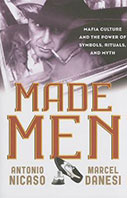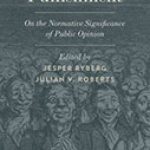Made Men: Mafia Culture and the Power of Symbols, Rituals, and Myth

Authors: Antonio Nicaso and Marcel Danesi
Publisher: Lanham, MD: Rowman and Littlefield, 2013. 182p.
Reviewer: David A. Marvelli | November 2014
In Made Men, Antonio Nicaso and Marcel Danesi demystify the culture of organized crime—what they refer to as the “mafia culture”—by incisively revealing the truths behind its most appealing characteristics of honor, rituals, and symbols. These are characteristics that are said to contribute to the survival and continuity of organized crime groups like the Italian and American mafias, the Yakuza, the Chinese Triads, and the Russian mob. By revealing the truth about the mafia culture and exposing the true nature of these murderous and treacherous criminal organizations, Nicaso and Danesi have provided an invaluable addition to the organized crime literature.
A large part of the myth woven by the criminal organizations and perpetuated by popular movies is the organizations’ origins. These origin stories, which most often combine historical people and events with legends, portray the criminal organizations as defenders of the oppressed. For instance, while the history of the Yakuza has been traced back to a band of early seventeenth century gangster-warriors known as kabuki-mono, who terrorized the people, the Yakuza denies this lineage in favor of a lineage to the machi-yakko, a group of small business owners who defended their towns and people. This allows for the criminal organization to portray itself as an honorable organization with a history of protecting the very people it is actually preying on.
Besides examining the myths surrounding the origins of the various criminal organizations with the attendant emphasis on a code of honor, Nicaso and Danesi provide chapters on the role symbols and appearances have on the larger myth of being a mafiosi or gangster. As with the origin stories, appearances are self-perpetuating with popular movies and television shows demonstrating how a “real” mafiosi should look and act. Appearances and symbols can also serve as a visual signal for members and non-members alike in identifying who is and is not a part of these organizations. In the case of the Yakuza and the Russian mob, tattoos play a significant role in self-identification. With outlaw motorcycle gangs, club patches serve not only to identify membership but also the individual’s rank within the organization.
Despite some examples drawn from Japanese, Russian, Chinese and other organized crime groups, this text does focus heavily on Italian organized crime and “criminal organization.” The very notion or phenomenon of “criminal organization” is debated among scholars and practitioners alike. A significant amount of academic research since Donald Cressey’s landmark Theft of a Nation, which outlined Italian organized crime in terms of a corporate structure, has argued for the importance of social network analysis and patron-client relations in understanding organized criminal activities.
While this text might cause some consternation about the holistic description of criminal organization and the broad branding of the various criminal groups with labels, such as “the Yakuza” or “La Cosa Nostra,” Made Men provides an invaluable addition to the organized crime literature by focusing on the characteristics of the mafia culture, which has contributed—among others factors to be certain—to the continuity of these criminal organizations. By revealing the true nature of the mafia culture, it dispels the popular appeal of organized crime membership. This text should therefore, be required reading in “culture-of-lawfulness” programs, which are aimed at deterring at-risk populations from joining criminal organizations and engaging in criminal activities.
David A. Marvelli is an intelligence professional for the Federal Bureau of Investigation (FBI). He received his PhD from Rutgers University.
The views and opinions expressed herein are those of the author and do not necessarily reflect the views of the Federal Bureau of Investigation or the U.S. Government.


